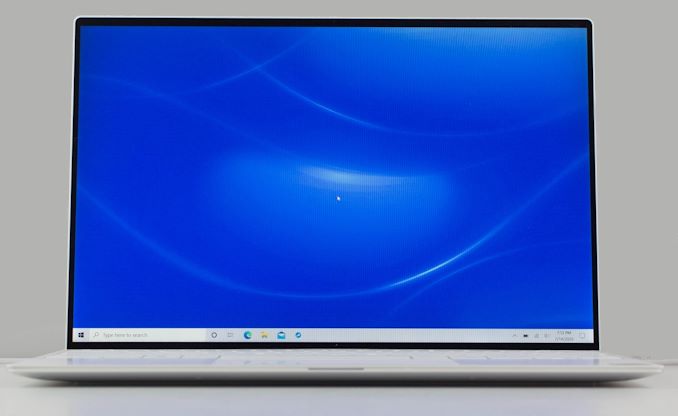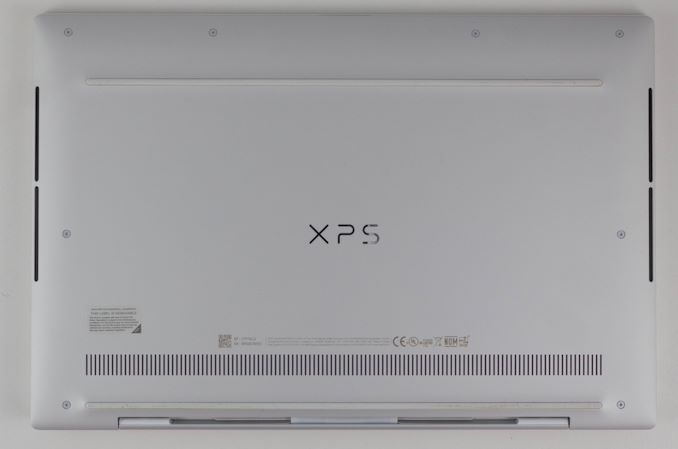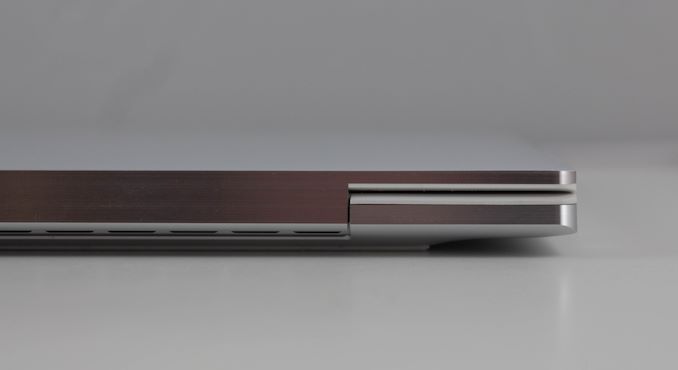The Dell XPS 13 (9300) Review: Return of the King
by Brett Howse on July 16, 2020 10:00 AM ESTFinal Words
Dell’s XPS lineup is one of the strongest in the PC industry. The InfinityEdge display was a revolution, allowing laptop sizes to shrink considerably, while providing the same display size. The new XPS 13 improves on an already excellent pedigree by moving to a 16:10 aspect ratio on the display which further reduces the bezel and keeps the new XPS 13 looking as fresh as ever.
The two color choices are both great, but the Arctic White, with its woven fiber keyboard deck, is really striking. Dell has tweaked this slightly from their original 2-in-1 design by moving back to black display borders, which can help hide the admittedly small bezels even further. The older soft-touch carbon fiber black color is still a great look as well. The refreshed XPS 13 is simply one of the nicest looking notebooks in its class.
The move to Ice Lake in the 2020 refresh is also a welcome addition, mostly thanks to the significantly improved integrated GPU performance, but also because it allows the laptop to support 32 GB of RAM. Coupled with the maximum 2 TB of SSD storage, and the XPS 13 offers plenty of performance for its size. There will be those that lament the lack of an AMD option, as AMD’s latest Renoir is a very potent platform, but the lead time on a notebook like this would preclude that option.
Dell’s decision to move to a 16:10 aspect ratio means that you get a bit more vertical space, which should be beneficial in most productivity scenarios. Of the two display options, unless the wider P3 gamut support of the 3840x2400 display is something critical for a specific workflow, the extended battery life of the 1920x1200 is likely the better option for most people. And, just so it is not forgotten, Dell’s anti-glare coatings are a shot in the arm for the PC industry, providing just 0.65% reflectivity, and when coupled with the very bright display, makes for a winner in almost any lighting condition.
Even the bottom of the XPS is well thought out. Torx screws surround the bottom which allow access inside if needed, and Dell continues to utilize rubber feet which span almost the entire width of the notebook, providing an incredibly solid footprint across a range of surfaces.
Open or closed, the XPS 13 is a fantastic looking device. It backs that up with excellent performance, and plenty of options to fit almost any budget. It is somewhat rare for a premium notebook to start at under $1000 USD, but Dell manages that, if only barely, but the base model now provides 8 GB of RAM and 256 GB of storage, which is much better than some of the XPS 13’s of old, which started with half that RAM and storage for the same price. Dells options are also very reasonable priced, so upgrading from the base model does not instantly launch the price into the stratosphere.
It is great to see Dell update their XPS 13 clamshell notebook to the same internals and design of their previously released 2-in-1 version. It is also great that you can opt for either the clamshell XPS 13, or the convertible 2-in-1, depending on your needs. The convertible offers some increased functionality that you cannot get in a traditional notebook, but there is also a large market that prefers the simplicity of the traditional design. With the XPS lineup, it is your choice.
Finally, in a very rare move, Dell offers not only Windows, but also Linux, giving buyers their choice on what operating system they get. It goes without saying that this is an incredibly uncommon thing on a premium notebook, and very welcome to see. In the case a buyer does opt for Linux, then the the XPS 13 Developer Edition, as it's called, comes from the factory with Ubuntu 18.04LTS.
Overall there is a lot to like about the new XPS 13, and very little to detract from. Dell has yet another winner. With an updated 16:10 display, class-leading battery life, and a fantastic design, the XPS 13 is easily one of the best notebooks around.














224 Comments
View All Comments
grant3 - Friday, July 17, 2020 - link
There's an excellent reason why ultrabooks might underperform: their cooling capacity is limited by the form factor.If CPU performance, or price:CPU Performance, were the only metrics which mattered to people, then ultrabooks & apple would not exist.
Spunjji - Monday, July 20, 2020 - link
@grant3 - the cooling system on that Acer Swift is pretty terrible!@Deicidium - the XPS 13 9300 launched in January this year - that's 6 months ago. It's the current competition for AMD's current mobile chips that launched one month ago. A comparison with a product that hasn't released yet isn't "more appropriate". 🤦♂️
Deicidium369 - Friday, July 17, 2020 - link
Ice Lake is almost a year old. The more appropriate comparison is the upcoming Tiger Lake, Anandtech has been slow to get a review unit for an almost year old design, while the next gen is being prepped for release.Santoval - Friday, July 17, 2020 - link
"Valid" in what sense? sorten is giving Intel a competitive benefit (or, alternatively, gives AMD a handicap) by comparing an AMD "craptop" with an Intel ultrabook; it's not the other way around.Spunjji - Friday, July 17, 2020 - link
Performance: No, not for Ice Lake.Power Consumption: Yes, but only for Ice Lake.
Price: Not even funny.
When you combine all three AMD currently come out easily on top, and yet...
Meteor2 - Thursday, August 20, 2020 - link
It's incredible how much people can argue about objective numbers.Deicidium369 - Thursday, July 16, 2020 - link
Tiger Lake is coming in the next month or so - Lenovo and Acer already have their systems working the Tiger Lake Core i7-1165G7 - 4 core + 96EU Xe LP wrecks the most powerful Renoir in iGPU (actually matching or slightly exceeding the MX350) and with double the CPU cores (4 Intel / 8 AMD) the AMD is only 17% ahead. So Yeah, way less performance from the AMD.Problem with AMD is they are still trying to get Skylake levels of performance, but Intel has well moved on from that architecture. Intel is solid as they come in ultralights/ultrabooks.
sorten - Thursday, July 16, 2020 - link
Not sure what you mean when you say "Problem with AMD is they are still trying to get Skylake levels of performance." Zen 2 mobile chips easily outperform Ice Lake and Comet Lake.Yes, we all expect the Xe iGPU to outperform AMD's iGPU. Intel has been humiliated for so long in this area that they've put all of their efforts into becoming competitive. In some respects, both brands targeted their competitor's strength, and gave up ground in theirs.
I'd personally prefer the CPU advantage, because if I'm doing anything with graphics that any decent iGPU can handle, I'd just use the Dell's TB3 port to hook up an eGPU. But everyone has their own priorities, I understand.
Cliff34 - Thursday, July 16, 2020 - link
The problem is that AMD doesn't support Tb3. So if you need Tb3 for anything you will end up buying Intel.PixyMisa - Thursday, July 16, 2020 - link
AMD does support TB3, as evidence by the fact that you can buy AMD devices with TB3.There just aren't many of them.